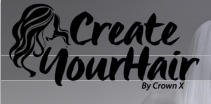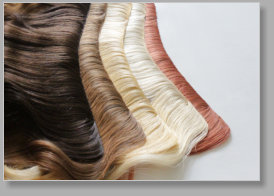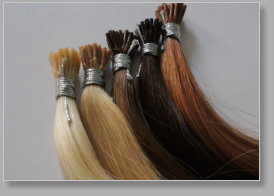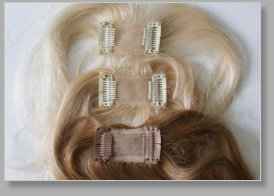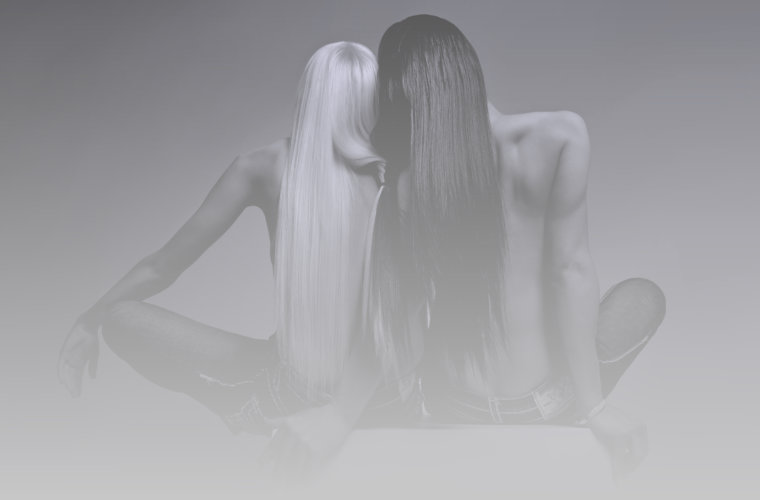



Question #4: Are hair
extensions recommended for
my thinning top hair?
Answer #4: In general, the answer is no, unless your hair is curly and short. The reason is that attaching hair extensions to your existing hair, requires the technician to use a cylinder tube, glue, tape or even a hair clip. For those who have thin hair on top, these methods of attachment show through your hair because a hair extension is simply a group of thin strands of hair in a round or flat form. However, for those who have short and curly hair, the thin hair on top can be easily covered by using extensions. Question #5: What is the right type of Human Hair Extension to choose? Answer #5: It is important to choose the right type of hair extension based on your hair condition, style, and how it fits into your life style. Therefore, it is important to consult with a hair professional who covers both the field of hair extensions and hair replacement. Question #6: If hair extensions are not right for me, what other method should I consider? Answer #6: You need to talk to a hair replacement specialist who knows hair extension techniques as well. Hair replacement is a unit that goes on top of the head to increase density naturally. If a person has thin hair on top or in the crown area, the proper way to go is a partial hair piece or a top piece. A full wig is designed to cover an entire head while the partial unit is designed to cover an exact area of thin hair or bald area. Note: Watch for the upcoming release of our exciting new product designed to meet these needs! Be sure to join our email list. Question #7: What types of Human Hair are being used for hair extensions? Answer #7: There are several different types of human hair being used in the current marketplace. The main sources are India and China while European human hair is limited in quantity. You can choose Cuticle-Intact human hair which is healthier than chemically stripped human hair that has been collected from cuticles with inverted hair (this type of hair is usually weaker than cuticle- intact hair and has a tendency of matting/tangling. Note: Our product is made of the highest quality of cuticle- intact hair and has minimal processing.Ask B.J.
Question #1: Who can
benefit from 100% Human
Hair Extensions?
Answer #1: Those individuals who wish to thicken and/or lengthen the sides and back of their hair. Also, our pieces are a perfect solution for those who want to change their look and style without making permanent modifications to their own hair.Question #2: What is the
main purpose and function of
Hair Extensions?
Answer #2: The basic purpose of hair extensions is to increase the length and provide more volume to the client’s existing hair.Question #3: What types of
Hair Extensions are available
on the market and how do I
choose the right type and
attachment method for me?
Answer #3: Basically, there are 4 types that are widely available now. Cylinder tube/”micro ring” method: These are attached by using a small tube made out of coated aluminum or copper, each with pre-glued hair strands. The strands are then pushed onto a cylinder tube after a piece of the individual’s own hair is pulled onto the cylinder. Pressing the round cylinder flat locks the hair extension onto existing hair. Note: Our products include this type of hair extension. Clip in method: A skirt-like hair drape is pre-attached with small clips. You can then simply clip it in onto your existing hair. You may use one layer or two layers depending on the required density. Clip in extensions come in two different strip widths – short or long. It takes only a few seconds to install onto existing hair by simply snapping it on, but like eye glasses, you may need to remove it at night. It’s the easiest extension to use and you can try it on by yourself. This is also the most economical way to consider hair extensions before you decide to permanently attach them. Clip in extensions outlast any other types of hair extension and no maintenance service is required other than to shampoo it once in a while. Note: Our products include this type of hair extension. Conventional weave/braid method: Using machine made weft, the technician sews a hair skirt-like weft onto the client’s existing track line. The process of track line sewing can pull existing hair, creating traction Alopecia. Therefore, this method is not recommended for those who have weak hair. For those who have strong hair, the method can be beneficial and machine made hair is rather inexpensive. Glue method: Using pre-glued individual extensions in a round or U shape form, each piece is individually attached to the same amount of client hair by applying heat, causing the melted glue to attach on to the hair. Attaching is simple, but removing the extension can be a problem depending on the type of glue being used or the technician’s technique. The technician may use a solvent or removing oil which can stress and damage weak hair. Smaller tiny glue extensions can be used in the frontal area or temple area of the head. Tape extension: There are two basic sizes (widths) for these extensions - 1.5" and 11" width. A layer of the client’s hair is laminated on the thin strip skin of one side, while double face adhesive tape of the same size is attached to another skin side. The concept of a tape extension is that it is easy to attach onto the hair by peeling off the protective waxed tape, then simply pressing it on client’s hair. It sticks to hair and lasts for a few weeks. The main advantage of this method is that it is simple to apply and feels natural when touched. However, removing tape extensions requires a special solution or oil to do the job. Moreover, reusing tape extensions is much harder as you need to remove existing tape, then reapply a new tape over. Unless you are a professional, it might be too complicated to do the job yourself. Because of simple attachment, this method is drawing attention but it is very hard to reuse the strips after the initial application.




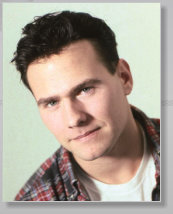
Ask B.J.

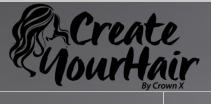
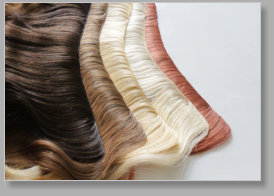

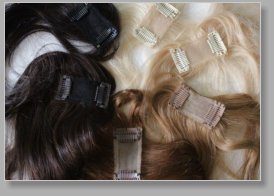

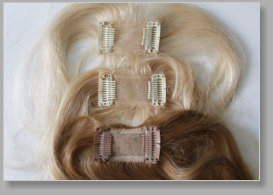
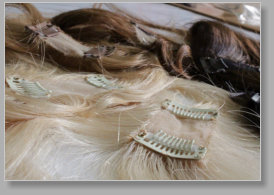
Join our Email List!




Question #4: Are hair extensions
recommended for my thinning top
hair?
Answer #4: In general, the answer is no, unless your hair is curly and short. The reason is that attaching hair extensions to your existing hair, requires the technician to use a cylinder tube, glue, tape or even a hair clip. For those who have thin hair on top, these methods of attachment show through your hair because a hair extension is simply a group of thin strands of hair in a round or flat form. However, for those who have short and curly hair, the thin hair on top can be easily covered by using extensions. Question #5: What is the right type of Human Hair Extension to choose? Answer #5: It is important to choose the right type of hair extension based on your hair condition, style, and how it fits into your life style. Therefore, it is important to consult with a hair professional who covers both the field of hair extensions and hair replacement. Question #6: If hair extensions are not right for me, what other method should I consider? Answer #6: You need to talk to a hair replacement specialist who knows hair extension techniques as well. Hair replacement is a unit that goes on top of the head to increase density naturally. If a person has thin hair on top or in the crown area, the proper way to go is a partial hair piece or a top piece. A full wig is designed to cover an entire head while the partial unit is designed to cover an exact area of thin hair or bald area. Note: Watch for the upcoming release of our exciting new product designed to meet these needs! Be sure to join our email list. Question #7: What types of Human Hair are being used for hair extensions? Answer #7: There are several different types of human hair being used in the current marketplace. The main sources are India and China while European human hair is limited in quantity. You can choose Cuticle-Intact human hair which is healthier than chemically stripped human hair that has been collected from cuticles with inverted hair (this type of hair is usually weaker than cuticle-intact hair and has a tendency of matting/tangling. Note: Our product is made of the highest quality of cuticle-intact hair and has minimal processing.Ask B.J.
Question #1: Who can benefit from
100% Human Hair Extensions?
Answer #1: Those individuals who wish to thicken and/or lengthen the sides and back of their hair. Also, our pieces are a perfect solution for those who want to change their look and style without making permanent modifications to their own hair.Question #2: What is the main
purpose and function of Hair
Extensions?
Answer #2: The basic purpose of hair extensions is to increase the length and provide more volume to the client’s existing hair.Question #3: What types of Hair
Extensions are available on the
market and how do I choose the right
type and attachment method for me?
Answer #3: Basically, there are 4 types that are widely available now. Cylinder tube/”micro ring” method: These are attached by using a small tube made out of coated aluminum or copper, each with pre-glued hair strands. The strands are then pushed onto a cylinder tube after a piece of the individual’s own hair is pulled onto the cylinder. Pressing the round cylinder flat locks the hair extension onto existing hair. Note: Our products include this type of hair extension. Clip in method: A skirt-like hair drape is pre-attached with small clips. You can then simply clip it in onto your existing hair. You may use one layer or two layers depending on the required density. Clip in extensions come in two different strip widths – short or long. It takes only a few seconds to install onto existing hair by simply snapping it on, but like eye glasses, you may need to remove it at night. It’s the easiest extension to use and you can try it on by yourself. This is also the most economical way to consider hair extensions before you decide to permanently attach them. Clip in extensions outlast any other types of hair extension and no maintenance service is required other than to shampoo it once in a while. Note: Our products include this type of hair extension. Conventional weave/braid method: Using machine made weft, the technician sews a hair skirt-like weft onto the client’s existing track line. The process of track line sewing can pull existing hair, creating traction Alopecia. Therefore, this method is not recommended for those who have weak hair. For those who have strong hair, the method can be beneficial and machine made hair is rather inexpensive. Glue method: Using pre-glued individual extensions in a round or U shape form, each piece is individually attached to the same amount of client hair by applying heat, causing the melted glue to attach on to the hair. Attaching is simple, but removing the extension can be a problem depending on the type of glue being used or the technician’s technique. The technician may use a solvent or removing oil which can stress and damage weak hair. Smaller tiny glue extensions can be used in the frontal area or temple area of the head. Tape extension: There are two basic sizes (widths) for these extensions - 1.5" and 11" width. A layer of the client’s hair is laminated on the thin strip skin of one side, while double face adhesive tape of the same size is attached to another skin side. The concept of a tape extension is that it is easy to attach onto the hair by peeling off the protective waxed tape, then simply pressing it on client’s hair. It sticks to hair and lasts for a few weeks. The main advantage of this method is that it is simple to apply and feels natural when touched. However, removing tape extensions requires a special solution or oil to do the job. Moreover, reusing tape extensions is much harder as you need to remove existing tape, then reapply a new tape over. Unless you are a professional, it might be too complicated to do the job yourself. Because of simple attachment, this method is drawing attention but it is very hard to reuse the strips after the initial application.
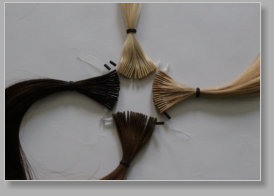




Ask B.J.

